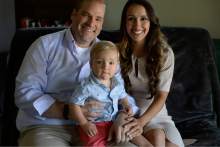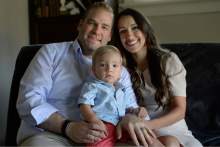This is an archived article that was published on sltrib.com in 2017, and information in the article may be outdated. It is provided only for personal research purposes and may not be reprinted.
When Heather and Benjamin Sessions exchanged wedding vows at the Salt Lake Temple in 2003, they knew they were ready to spend the rest of their lives together. But they also knew that they were not yet ready to have children.
The couple worked long hours in the years after they married, Heather as a national sales manager for Verizon and Benjamin as a case manager for an insurance company. It wasn't until last year, when they'd progressed in their careers and had saved up a nest egg, that they felt prepared to add a new member to their family.
"People say you'll never be ready for kids, but we were ready, financially and emotionally," Heather said recently at the couple's home in Sugar House, as her 15-month-old son, Gaius, sat on her lap. "But it took us 13 years to get there."
Benjamin, 35, and Heather, 31, represent a new reality in Utah — which has lost its more than 25-year distinction as the state with the nation's highest general fertility rate.
Utah remains, by far, the state with the highest birthrate — which compares the number of births to the total population, regardless of age or sex. The general fertility rate — generally considered a more accurate measure — is the number of live births per 1,000 girls and women who are between 15 and 44 years old.
Utah women have long had more children than American women do on average. But in a shift that accelerated in 2008, the state's young women began having fewer children. The number of babies born to women ages 20 to 24 decreased more than 28 percent between 2007 and 2015.
The number of women in that age group having their first child decreased by more than 25 percent.
In 2015, the fertility rate in South Dakota increased to 78.2, just high enough to overtake Utah, which had a fertility rate of 78.0.
—
'When is as soon as possible?' • In June, the Centers for Disease Control and Prevention released provisional data for births in 2016 that show the national birthrate fell by about 1 percent, to the lowest level ever recorded.
While the Utah Department of Health won't release official birth data for 2016 until later this year, the state may be headed in the same direction as the rest of the country.
The number of births at 16 Utah hospitals decreased by just over 1 percent compared to 2015, according to data the hospitals provided to The Salt Lake Tribune. Births at those hospitals represented more than 60 percent of all Utah births in each of the past four years.
"Births in Utah peaked in 2008, just like they did nationally, but the number of births keeps going down every year since the Great Recession," said Pam Perlich, director of demographic research at the Kem C. Gardner Policy Institute at the University of Utah. "We're following the national trend."
The fertility rate in Utah decreased in 2009 and 2010 by more than 4 percent, according to the state health department. But even as the economy improved, the state's fertility rate continued to decline. In 2015, it was down about 2.5 percent compared with 2014.
Andrew Applegate, 25, and his wife, Kara Applegate, 27, married two and a half years ago, but they decided to put off trying to start a family until recently.
"We want to have kids as soon as possible," Andrew said. "But the question is, 'When is as soon as possible?' And for us that was when my wife had graduated."
He is currently in law school at Brigham Young University and until May, Kara was a full-time student at the University of Utah School of Medicine. Since she finished school and began a hospital residency in Salt Lake City last month, the couple decided they are ready to try to have children.
"It was just a matter of hey, we want to get our financial universe in order and we want to get through school," Andrew said.
While fewer young women in Utah are having children, more women in their 30s are giving birth. Between 2007 and 2015, births to women ages 35 to 39 increased nearly 40 percent.
The number of women in that age group who were having their first child increased more than 30 percent.
As Utahns wait until later in life to have children, they have less time to grow their families. Doctors recommend that women wait about 18 months between giving birth and getting pregnant again, in order to prevent premature birth and other health problems for the child.
—
'There's no rush' • The previous generation may be having some influence on younger Utahns' decisions.
Stephen C. Voss, an obstetrics and gynecology specialist at St. Mark's Hospital, has delivered thousands of Utah babies in his 35-year career. Some of the babies he delivered grew up and came back to him as patients with their own children on the way. He said he's seen the trend evolve firsthand.
"I'm seeing the effects of counseling people are getting from their parents, from their mothers, and I'm seeing much less of that advice from the generation above to have your children early," he said.
Warren Driggs, 61, and his wife, Cindy, of Salt Lake City, had the first of their four children when he was 25 years old. When those kids grew up, he had some advice for them about when to start a family.
"There's no rush," Driggs said. "You'll be married for a long time, hopefully. Get your education."
Driggs now has six grandchildren, but his kids all waited until their early 30s to start families, he said. "I really endorse the institution of marriage," Driggs said. "But I don't see what the urgency [to have children] is about."
More Mormons have children than members of any other religion in the country, according to a 2014 study conducted by the Pew Research Center. But The Church of Jesus Christ of Latter-day Saints does not advise members about how they should plan their families.
"The decision of how many children to have and when to have them is a private matter for the husband and wife," according to the official LDS Church website. "Decisions about birth control and the consequences of those decisions rest solely with each married couple."
At Midvalley 11th Branch in Sandy, a small congregation of the LDS Church, a majority of the members are young couples, said Rob Flygare, branch president. And many of them do not have children.
"I see a lot of couples who get married who are still in their early career opportunities and still in school and they're putting off their families," Flygare said.
In the past, Flygare said, he often heard people in the church encourage young couples to start families right away. He doesn't give suggestions either way.
"I think it's a very personal decision," Flygare said. "It's between them and what they want to do starting their families."
—
'Becoming something new' • If Utah parents continue to have fewer children, new additions to the state will likely keep it at the top of national birthrate rankings for years to come.
Utah's population is the fastest growing of any state in the country, according to U.S. census data released in December, and in-migration is a significant reason. People moving into the state will drive about a third of the projected growth of 2.53 million people over the next half century, according to a 2016 report by the Kem C. Gardner Policy Institute.
Many of those new arrivals are in their 20s and 30s, the typical age to start a family.
With the addition of children that newcomers give birth to in the state, in-migration is responsible for about half of the population growth in Utah since 1990.
"As the economy diversifies, our connection to the outside world increases. That's what's bringing the change to the state, through markets, technology and immigration," Perlich said. "Utah is no longer what it used to be in the past. It's becoming something new."
After waiting to be a parent, Heather Sessions wouldn't advise her younger self to "change your life and have kids at 25," she said, "but I would say you will find this so much more fulfilling than you would ever know."
Watching Gaius crawl around their living room, she said, "We've been to some incredible places: the Taj Mahal, the Egyptian pyramids and Petra in Jordan. And none of them come even close to how amazing this little kid is."











